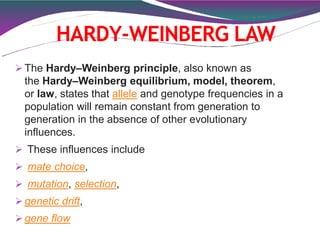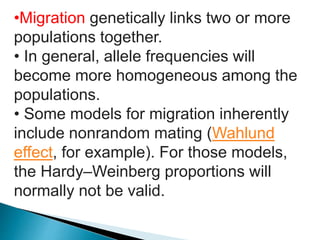Hardy weinberg law
- 1. ïŠ PRESENTED BY : ïŠ SRISHTI AGGRAWAL ïŠ M.SC BOTANY ïŠ DEPT.OF SCIENCE ïŠ DEI,AGRA ïŠ PRESENTED TO : Dr. AJAY KUMAR ïŠ DEPT.OF SCIENCE ïŠ DEI,AGRA
- 3. HARDY-WEINBERG LAW ï The HardyâWeinberg principle, also known as the HardyâWeinberg equilibrium, model, theorem, or law, states that allele and genotype frequencies in a population will remain constant from generation to generation in the absence of other evolutionary influences. ï These influences include ï mate choice, ï mutation, selection, ï genetic drift, ï gene flow
- 4. ï― organisms are diploid âĒ only sexual reproduction occurs âĒ generations are nonoverlapping âĒ mating is random âĒ population size is infinitely large âĒ allele frequencies are equal in the sexes âĒ there is no migration, mutation or selection
- 5. âĒ Random mating. The HWP states the population will have the given genotypic frequencies (called Hardyâ Weinberg proportions) after a single generation of random mating within the population. âĒ When the random mating assumption is violated, the population will not have HardyâWeinberg proportions. A common cause of non-random mating is inbreeding, which causes an increase in homozygosity for all genes.
- 6. âĒ Selection, in general, causes allele frequencies to change, often quite rapidly.
- 7. âĒ While directional selection eventually leads to the loss of all alleles except the favored one (unless one allele is dominant, in which case recessive alleles can survive at low frequencies), some forms of selection, such as balancing selection, lead to equilibrium without loss of alleles.
- 8. âĒ Mutation will have a very subtle effect on allele frequencies. âĒ Mutation rates are of the order 10â4 to 10â8, and the change in allele frequency will be, at most, the same order. âĒ Recurrent mutation will maintain alleles in the population, even if there is strong selection against them.
- 9. âĒ Small population size can cause a random change in allele frequencies. âĒ This is due to a sampling effect, and is called genetic drift. âĒ Sampling effects are most important when the allele is present in a small number of copies.
- 10. âĒMigration genetically links two or more populations together. âĒ In general, allele frequencies will become more homogeneous among the populations. âĒ Some models for migration inherently include nonrandom mating (Wahlund effect, for example). For those models, the HardyâWeinberg proportions will normally not be valid.










